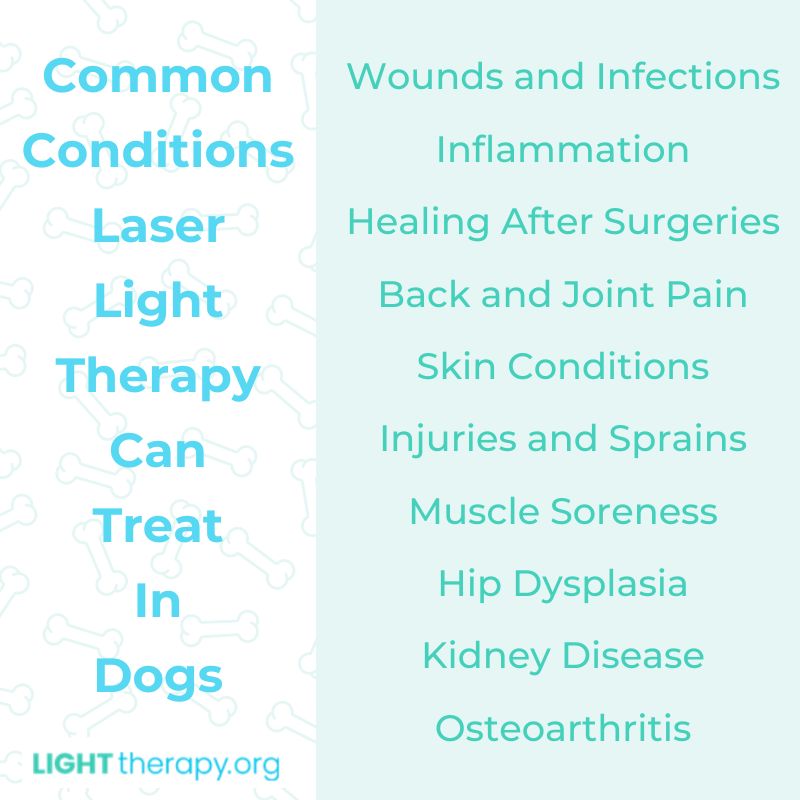Does Laser Light Therapy for Dogs Really Work?
There’s a reason dogs are man’s best friends. Studies show that sharing your home and your life with a dog can decrease stress, lower blood pressure, and even help you achieve nearly 3,000 additional steps per day!
It’s no wonder you’re willing to do whatever it takes to make sure your canine companion is happy and healthy. That includes investing in laser light therapy for dogs.
Laser Light Therapy
You may have heard of using laser light therapy to treat medical conditions in humans, but over the last few years, laser light therapy for dogs has gained recognition in veterinary medicine.
We humans have been enjoying the benefits of light therapy for decades. Medical professionals use it to treat conditions like acne, eczema, lymphoma, joint pain, and even seasonal affective disorder. Due to a recent explosion of at-home devices, even more people have jumped on the laser light therapy bandwagon!
Depending on the condition, light therapy incorporates various wavelengths of light from the color spectrum. The most common are blue and red light, but more niche types of light therapy devices also use wavelengths of green, purple, and infrared light.
This light can be applied using a type of laser, which allows the light to penetrate deep beneath the skin’s surface. Using a laser is a non-invasive option with little to no side effects. After repeated sessions, laser light therapy may heal and regenerate cells within your body, tackling a host of diseases and other medical issues.
The same basic principles apply to laser light therapy for dogs and other pets. Scientists have conducted fewer studies in pets than in people, but the clinical data so far has shown very positive results.
It seems the more we learn about laser light therapy, the more popular it gets — for people and pets!
What About Laser Light Therapy for Dogs?
Multiple clinical studies have tested the effectiveness of laser light therapy on conditions that affect dogs specifically.
In a 2017 study, for example, laser light therapy with near-infrared light expedited the healing process for dogs who underwent bone surgery. Those who received light therapy healed better than the placebo group, even though they were much older dogs!
Since there seem to be relatively few side effects, if any, in animals, many veterinarians have embraced the science of laser light therapy to treat a wide variety of canine conditions. Here are a few common conditions laser light therapy can treat in dogs:
- Wounds and infections
- Inflammation
- Healing after surgeries
- Many types of pain, like back and joint pain
- Various skin conditions
- Injuries, such as sprains
- Muscle soreness
- Hip dysplasia
- Kidney disease
- Osteoarthritis
Laser light therapy seems to be particularly effective at treating canine arthritis. During a 2018 study, researchers saw positive results when using near-infrared light to treat elbow osteoarthritis in dogs.
The dogs in this study saw many improvements, including improved pain management and less physical weakness during the healing process. They also needed less pain medication — some participants needed as much as 50% less medication than those who did not receive laser light therapy! Other studies have yielded similar results.
Thankfully, researchers have found virtually no harmful side effects of laser light therapy for dogs. This makes it an excellent treatment option for even the most discerning of pet owners!
How To Use Laser Light Therapy for Dogs
You might worry that your dog is too hyper or not trained enough to sit still for laser light therapy treatments. But the process is simpler than you think!
Before starting a laser light therapy treatment session, take your dog on a walk to drain any extra energy. Wait until shortly after mealtime to begin the treatment to ensure your dog isn’t antsy with hunger. Small dogs can sit in your lap, while larger dogs can lie on the floor or across a couch. Exceptionally hyper dogs may need to use a crate or a leash.
When using your preferred laser light therapy for dogs device, follow the provided directions closely. Part your dog’s fur so the light can reach the skin as closely as possible. Be sure to have a water dish nearby in case your dog gets thirsty. As the treatment process progresses, offer your dog lots of treats and much-needed praise.
Take breaks as needed until you’re finished. Depending on the size of the treatment area, the laser light therapy session could take a few minutes to several hours. Be patient and give your dog plenty of attention during and after the treatment.
Consult Your Vet
Before starting any type of treatment regimen, consult with your regular veterinarian. Your vet can help you decide if laser light therapy for dogs is a good option for your pup. If the treatment is not offered in the office or if it’s too expensive, your vet will help you find a home device that works for your dog’s needs.
Do not use light therapy as a replacement for prescription medication or any other type of medical treatment without consulting your vet first. In many cases, it’s best to supplement other treatment options, not replace them.
When used appropriately, laser light therapy can greatly improve your dog’s quality of life and give you many more happy years together!
